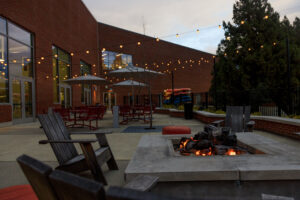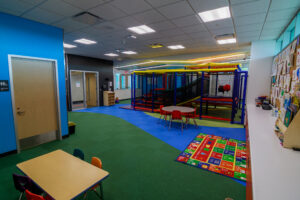Explore Innovative Spaces That Inspire Engagement and Belonging
Building Community Through Facility Design & Usage
Building a strong campus community is essential to student success and well-being. To foster a sense of belonging, campuses are designing multi-use spaces that encourage spontaneous interaction and connection. Two key trends—multipurpose design and open-concept spaces—are transforming campus environments, creating more flexible, collaborative hubs that support social engagement, wellness, and adaptability. Here are a few examples from CENTERS-managed locations where these principles are shaping the student experience.
Common Areas and Social Interaction
Well-designed common areas serve as the heart of campus life, providing students with welcoming spaces to gather, relax, and engage. These areas are essential in creating a sense of belonging, which directly impacts student retention and satisfaction. Whether incorporated into recreation centers, student unions, or informal lounge areas, common spaces encourage spontaneous interactions and strengthen campus culture.
Multi-Purpose Design
 Flexibility in facility design allows campuses to make the most of their spaces, supporting various student needs and experiences. Multi-purpose areas can transform for different events, maximizing their impact and use.
Flexibility in facility design allows campuses to make the most of their spaces, supporting various student needs and experiences. Multi-purpose areas can transform for different events, maximizing their impact and use.
At Jacksonville State University (JSU), common areas are intentionally designed to activate student social life. With a combination of indoor and outdoor passive spaces and flexible seating arrangements, JSU fosters an environment where students can connect organically. Without a dedicated student center, these shared spaces accommodate a range of activities and events, ensuring they remain valuable and adaptable over time. Outdoor seating areas, open gathering spaces, and adaptable indoor layouts allow the university to host diverse programming while maintaining an inviting atmosphere for everyday student use. By prioritizing versatility, JSU ensures that its facilities evolve alongside student needs.
Open-Concept Design
 The trend of open-concept design is redefining how student spaces function, blending social, academic, and event uses into a cohesive environment. This approach encourages collaboration and interaction while maximizing space efficiency. Even older facilities can be repurposed to align with this evolving standard.
The trend of open-concept design is redefining how student spaces function, blending social, academic, and event uses into a cohesive environment. This approach encourages collaboration and interaction while maximizing space efficiency. Even older facilities can be repurposed to align with this evolving standard.
For example, the University of New Haven (UNH) transformed its 2008 recreation facility into a central event hub for the campus. Originally designed for fitness and wellness, the space now also serves as the primary event center, hosting orientations, international student programs, and admissions events. By adapting its existing facilities, UNH demonstrates how campuses can reimagine space to better serve their evolving student populations.
Connecting to the Larger Community
 Campus facilities serve students and provide opportunities to build bridges with the surrounding community. Whether through shared-use agreements, community programming, or strategic partnerships, institutions can leverage their spaces to foster stronger external connections.
Campus facilities serve students and provide opportunities to build bridges with the surrounding community. Whether through shared-use agreements, community programming, or strategic partnerships, institutions can leverage their spaces to foster stronger external connections.
At Moraine Valley Community College (MVCC), dedicated spaces for youth programs bring local residents onto campus, reinforcing the college’s role as a community hub. These spaces regularly host events and activities that engage both students and the broader public.
Similarly, Harper College strengthens its connection to the community through shared facilities. With multiple tenants, including a parks district, the campus fosters direct ties to local organizations. Harper’s new student union, currently under construction, will physically link to these community spaces, further embedding the college within the broader regional network.
Powerful Designs Create Powerful Spaces
Intentional facility design plays a critical role in shaping campus culture and fostering meaningful student connections. By integrating common areas, multi-purpose spaces, and open-concept designs, institutions create dynamic environments that promote social interaction, adaptability, and wellness.
The strategies employed at Jacksonville State University, the University of New Haven, Moraine Valley Community College, and Harper College illustrate the power of well-designed spaces in enhancing both student life and community engagement. As campuses continue to evolve, the thoughtful use of space will remain a key factor in fostering belonging and connection—both on campus and beyond.
